In this article, you’ll learn what is cylinder block? how does it work? Its parts, function, and types of cylinder block are explained in detail with diagrams.
You can download the PDF file of this article at the end of it.
What is Cylinder Block?
An engine block is a structure that contains cylinders, and other parts of an internal combustion engine. In old engines, the engine block has only the cylinder block, to which a separate crankcase was attached.
In modern engines, the engine block consists of the crankcase integrated with the cylinder block as a single component, giving a rigid structure. Engine blocks also often include elements such as coolant passages and oil galleries.
The cylinder block, cylinder head, and crankcase are the three parts that form the foundation and main stationary body of an automobile engine. They serve as support an enclosure for moving parts.
The cylinder block may also have a separate crankcase for the crankshaft, which is limited to larger engines, marine, and stationary engines. A separate aluminum crankcase would result in saving weight as well as enable cheaper and quicker replacement.
Read Also: What is Fuel Injection Pump? Diagram, Parts, Working, Types [PDF]
Parts of Cylinder Block
Following are the parts of the cylinder block:
- Cylinders
- Oil passages and galleries
- Deck
- Crankcase
- Head studs
- Core plugs
- Water pump mounting
- Oil filter
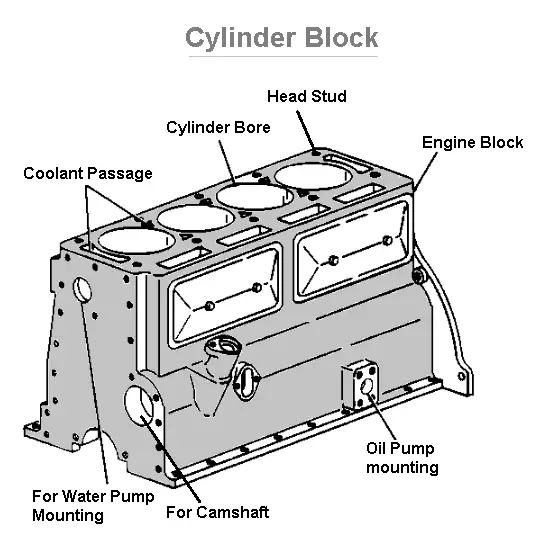
1. Cylinders
Cylinders are the parts in which the movement of the piston takes place. They are generally made of large size and have holes to form a seal with the piston. The number of cylinders holds power and the size of the engine.
2. Oil Passages and Galleries
These are essential components of the cylinder block for lubrication purposes. These provide oil to reach the cylinder head and crankshaft.
3. Deck
This is the top surface of the block where the end of the cylinder remains.
4. Crankcase
This component houses the crankshaft and is found under the modern engine block.
5. Head Studs
These are typically manufactured from a round rod of alloy steel. Threads are applied at both ends. This allows a tighter fit in the block, which prevents the stud from loosening when the stud nut is removed.
6. Core Plugs
A core plug is a cap of the engine block at the end of a coolant passage, which is used to prevent leakage of water or coolant from the engine.
7. Water Pump Mounting
A water pump is provided on the side of a cylinder block in housing coupled with a coolant casing.
8. Oil Filter
It is typically located either on the flank or under the engine block. There is an oil filter that keeps as many contaminants out of the lubricant that circulates the engine.
Read Also: How Does A Air Brake System Work?
Material Used in Cylinder Block
The cylinder block is usually made from gray cast iron, and sometimes with the addition of nickel and chromium. Some blocks are cast from aluminum, in which cast iron or steel sleeves are used.
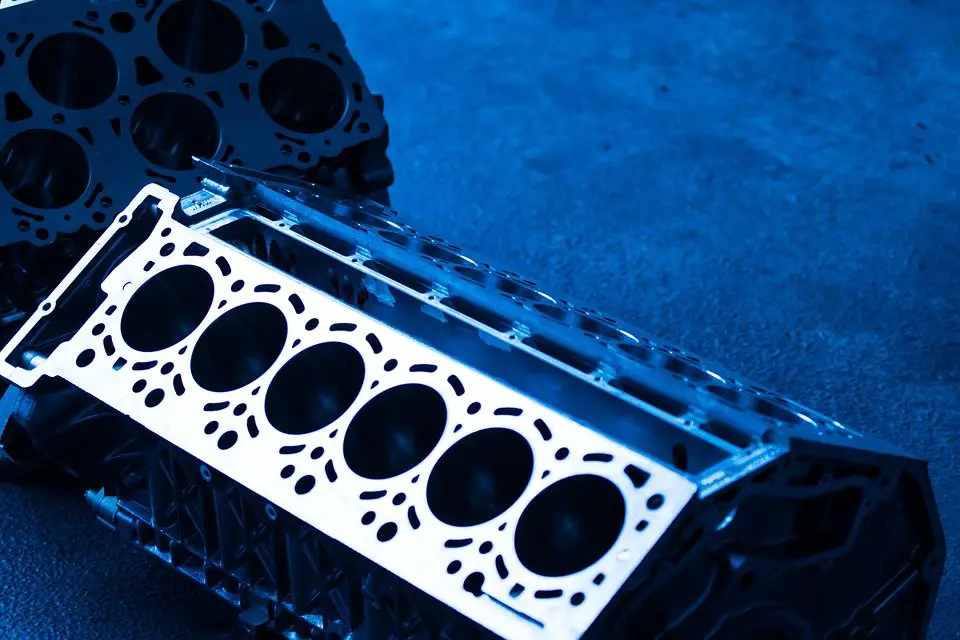
For most engines, cast iron has been found to be a satisfactory cylinder wall material, as it has better wearing qualities. In some small engines, the cylinder walls are placed with chromium, a very hard metal, to reduce wall wear and to increase their service life.
Tests are being carried out on high silicon-aluminum alloys to determine their possibilities as a material for cylinder block and crankcases. These alloys have a low coefficient of thermal expansion and high wear resistance.
Functions of Cylinder Block
The L-head engine blocks contain openings for the valves and valve ports. The bottom of the block also supports the crankshaft and oil pan. On most engines, the camshaft is supported in the cylinder block by a bushing that fits into machined holes in the block.
In L-head inline engine, the intake and exhaust manifolds are connected to the side of the cylinder block. On I-head engines the manifolds are joined to the cylinder head. Other parts attached to the block include the water pump (at the front), timing gear or timing chain cover (at the front), flywheel and clutch housing (at rear), ignition distribution, and fuel pump.
the cylinder head is mounted on the top of the block. Some parts are attached to the cylinder block with sealing gaskets which provide a good seal to prevent leakage of water, oil, or gas. Some parts are attached with bolts and others with studs and nuts.
In some places, lock washers are placed under the nuts or bolt heads. Water-cooled engines have passages around each cylinder, valve, and spark plug.
The circulating water keeps the engine at its exact working temperature and prevents excessive expansion and therefore deformation, ultimately preventing the breakdown of relative moving parts.
Types of Cylinder Block
Engine blocks are classified according to the size of the engine cylinders.
Following are the types of cylinder blocks:
- V-engine cylinder
- Inline cylinder
- Opposed engine or Boxer engine cylinder
#1 V-engine Cylinder
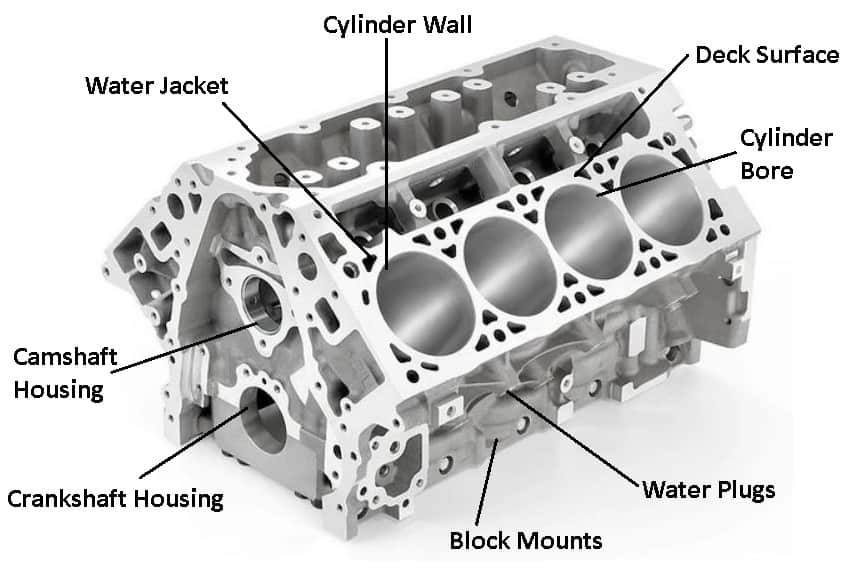
This is the modern engine cylinder and is widely used nowadays. In this configuration, the engines are provided in two rows. These two rows are placed at an angle to each other. The angle V is kept between 15° to 20°, as a larger angle makes it more difficult to balance the engine.
These are difficult to balance with the counterweight on the crankshaft. There are different types of v engines, V16s, V8s for heavy vehicles, and V4s for small motorcycles are used as cylinder blocks.
#2 Inline Cylinder
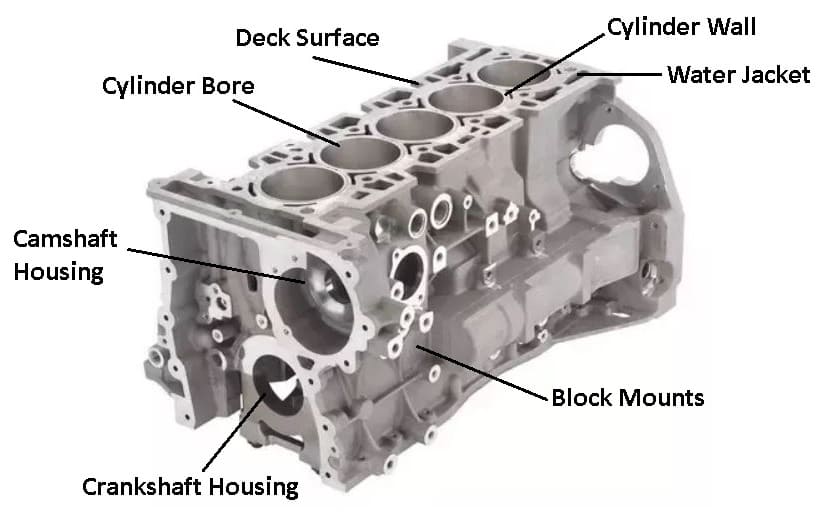
An inline engine is a type of cylinder block, in which a series of cylinders are arranged in such a way that they run in a single line. Vehicles with this type of cylinder block operate smoothly. They are mostly used where high rpm is needed. It is often used in passenger cars.
#3 Opposed Engine or Boxer Engine Cylinder
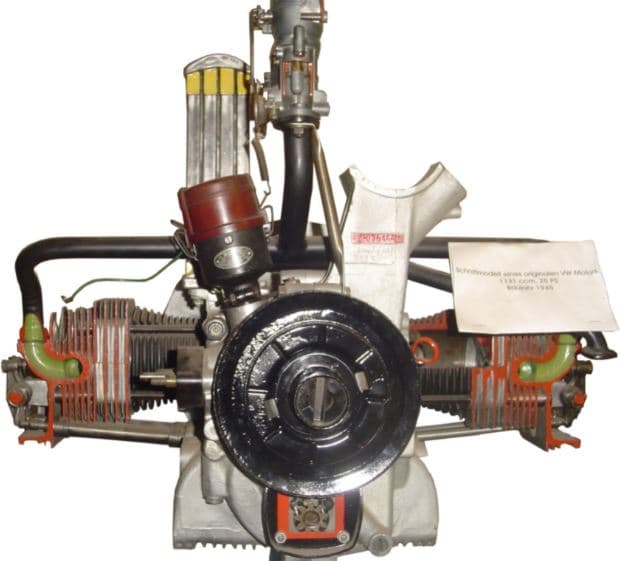
The Boxer engine is a flat pressed V engine. In this engine cylinder, the blocks coming in two rows of two cylinders are set as opposed to each other. They are also known for pancake engines.
They require very little headroom as the engine compartment can be very small. These are commonly seen on 4 cylinder Volkswagen engines. In addition, they are also employed on Porsche and Subaru and some other high-speed engines.
Read Also: Different Types of Motorcycles Explained [Names & Pictures]
Problems of Cylinder Block
When cylinder blocks continue to operate, they sometimes break or wear out. Let’s see what are the problems that make them worse.
- Leakage of external engine coolant
- Worn or cracked cylinder
- Porous engine block
1. Leakage of External Engine Coolant
This leak could be from the water pump, radiator, heater core, or a loose hose. Sometimes it can also be due to engine block because of cracks.
2. Worn or Cracked Cylinder
After the cylinder has been in operation for a long time, wear inside the cylinder is a common problem. This can damage the smooth machined wall and affects the sealing by piston rings. It can be avoided by increasing the bore size.
3. Porous Engine Block
This is usually caused by contaminants that enter the metal. This often happens while the manufacturing process is going on. You can’t avoid this problem because that’s where the cylinder block originated.
FAQ
Cylinder blocks are used to maintain engine stability and lubrication when withstanding various temperatures and loads. At the same time, they transfer oil to all parts of the engine, through multiple oil galleries, lubricating all important components.
The cylinder block is a structural member that extends upward from the centerline of the main support for the crankshaft to the junction with the cylinder head.
Wrapping It Up
As you know now, the cylinder block is a structure that houses the cylinders and other engine parts of an internal combustion engine. So now, I hope I’ve covered everything about the cylinder block parts, and their function.
If you still have any doubts or questions on “types of cylinder block”, you can ask in the comments. If you like this article then please share it with your friends. Subscribe to our newsletter to get notified when we upload new posts. It’s Free.
Download PDF file of this article
Read more such interesting articles in our blog:
thank you very much. Very informative post. i have learned too much upon reading.
You’re welcome! I’m thrilled to hear you found it informative and that you learned a lot.
I have learn something special in vehicles
Thanks for your feedback.
Very informative and educative
Thanks for your feedback.
Hi thanks I support.
You’re welcome.
Thanks for all the helpful information I am definitely smarter and better mechanic today
I’m glad you liked it. Thanks for reading.